| March
2011
How
to start, when you're trying to give a short impression of the trip
down memory lane, of the roads one has travelled, the more or less
helpful detours, of the folks 'met en route' and all the anecdotes you
keep in mind.
The story we tell especially target
those who have known and accompanied Auditorium23 right from the start:
the DIYers, music lovers and aficionados, the ones who wanted to make
their own large and small discoveries aside off the beaten tracks. They
came to us because we were – whacky like them – fascinated
by a way of music reproduction that at the time was regarded by many as
a kind of 'sectarianism' and ostracized by the media on a large scale.
Instead
of trendy 'tall-boys' we preferred historical horn speaker systems,
flee-powered tube amps instead of solid-state wattage-monsters,
bulky vinyl spinners instead of handy CDPs providing
“lossless“ playback of recorded music. Freaky! The internet
did not exist back then and insertions were expensive and only reached
a limited number of readers. When we distributed “LES
RÉALISATION de L'AUDIOPHILE“ and later “SOUND
PRACTICES“ in Germany, less than 50 subscriptions were sold.
At
the time, loudspeakers that could be driven by our L'Audiophile amps
and later on by the Shindo amps were not available as items from
current production. In order to be able to provide adequate speakers
for our electronic line-up, we had to arduously search for historical
components and to build customized cabinets for each individual client.
Those custom-build speakers were often large and did not fit
comfortably into ones living rooms in any case.
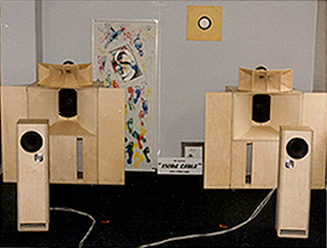
Voice of the Theatre and Triangle TQWT
at the Auditorium in 1989 |
As
a manufacturer – unlike in the DIY community – we were also
obliged to grant warranties on our products. But how could we grant
guarantee for components only available in the vintage market. Hence,
we were always looking for a manufacturer who was building speaker
drivers with the desired materials and according to historical
production principles.
A friend from France, journalist by profession, introduced Bernard Salabert
to
us. He pursued such goals with his recently founded company PHY-HP. The
PHY-HP drivers finally enabled us to build loudspeakers in a serial
without compromising on our idea of music reproduction. Furthermore
they allowed us to utilize smaller cabinets, which opened the
path for new and exciting discoveries.
The rest of the story
is well known and the loudspeakers developed in the following years (in
addition to speaker kits that we offered) are shown on this website and
described en detail beneath the links below.
In
the public eye, the image of A23 morphed astoundingly fast. Called horn
nuts before, we were now considered to be wideband morons. Opinions on
our PHY-HP based speakers ranged from “thanks, but no
thanks“ to “you‘ll have to kill me before giving them
back“. Our “Interior view“ tells a bit about the lessons you learn from wrong timing.
The
preference for vintage audio was never forgotten, it merely flourished
in the shadows. Circumstances were much too difficult for an honest
attempt to make this specialized field of music reproduction accessible
to a wider audience. However, it did not prevent ourselves from
acquiring as many vintage audio products as possible in order to learn
from them. As a result, our “Hommage“-line was born.
Today the ball is passed back to us
Those
who have engaged themselves with the restoration of vintage cars will
certainly remember times when it was almost impossible to find original
spare parts. Today, newly fabricated spare parts are available in all
instances for the restoration of timelessly beautiful classic cars.
In
the world of audio, gladly the same holds true. What we learned from it
was, that a certain way of enjoying music has gathered a larger base
over time – and on a greater scale than we could have hoped for
in the past. Original audio gear from the 1920s and 1930s for e.g. the
ones from Western Electric, Klangfilm or Westrex are sought after
collectors' items world wide, very expensive and thus cannot be
afforded by most aficionados of such systems. The demonstration of such
a WE-system (L9) by Silbatone at the High End 2010 in Munich not
only led to crowded audiences, but also to a distressed believe in
a supposed progress by more than a few exhibitors. A progress that
often comes along with music reproduction characterized by fragmented
tonal structures and the complete absence of an organic coherence.
Miracles do happen
The
globalized world is close meshed network and offers opportunities we
couldn’t even dream of in the past. It seems that a long time had
to elapse before the appreciation of reproduction systems
that we favoured to develop became distinctive. And obviously it
needed the foundation of a company
in China, whose owner shared this passion.
We
are excited to have been granted the distribution rights for the
products of Line-Magnetic Audio in Germany and its neighbourhood
countries. And we are even more excited that this leads us back to our
roots.
In the summer of 1985 we attended the first demonstration
of a WE 15A/555 system in Paris at a small auditorium near Place
Pigalle. It was organized by our later distribution partners from
L‘Audiophile. Listening to Barbara‘s
“Göttingen“ via WE 25B (from the collection of
J.C. Verdier) and also to Nemesis, left long lasting memories. Close
friends might know, how long we have wished for a re-launch of such
components. The fact that these drivers and horn designs are now
available from China reveals, that the idea of an inimitability of a
product has become part of serious considerations in China too. In
the past we could only dream of coming that close to the original
with such craftsmanship – all in all resulting in a sound of
timeless beauty. We believe that LineMagnetic Audio truly deserves our
appreciation.
The fact that the owner of LineMagnetic-Audio is
ardent collector of historical audio components rules out the
assumption, that the replicas cannot bear comparison with the original
drivers. Just the opposite is true: the materials are carefully chosen
appropriate to the originals and the detail work is astonishing. The
first replica of WE 22 A horns and WE 555 drivers – along with
prototypes of WE 755 arrived in Frankfurt in summer 2010, while another, larger delivery arrived in December of the same year. The
feedback we get from new owners is enthusiastic. As for us, a door to a
whole new world of sound has been opened for them, where music is
reproduced with fascinating subtlety and captivating authenticity
– and where one is perplexed when considering, in which epoch
these components were first developed. It's incredible, how fresh and
modern these alleged historical speakers do sound.
Line-Magnetic WE 22 A
Finder keeper
A
loudspeaker concept that has been in work for several years, prompted
us to search for appropriate alternatives related to the WE 555. We did
this in collaboration with our partner in the US, Jonathan Halpern of
Tone Imports. From Racon to Vitavox, from RCA-variants to certain
Jensen types: several drivers proved to be interesting in the testing
phase, but ultimately remained problematic when it came to
disposability and the modifications required to realize our project.
The casual phrase “let‘s check out these Chinese
drivers“ resulted in the developments described above.
Distribution rights were granted very quickly for us and the American
importer.
Of course we do listen to the replicas in comparison
to the historical originals and believe that the perceived tonal
differences are more a reflection of aging effects than that of a
different level of craftsmanship.
The journey remains exciting – stay tuned!
Product details

Arrival of the first delivery in summer 2010
| 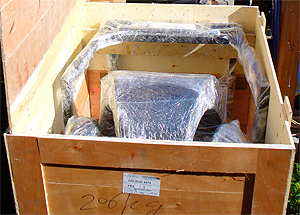
Horn and stand come in a wooden box, first-class packaged
and secured
| 
Line-Magnetic WE 555 driver
| 
Line-Magnetic WE 755
| 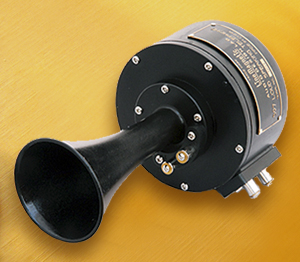
Line-Magnetic WE 597
| 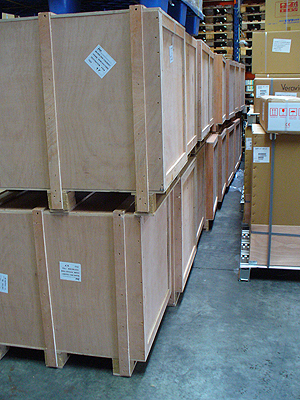
Arrival of the second delivery
in December 2010
| 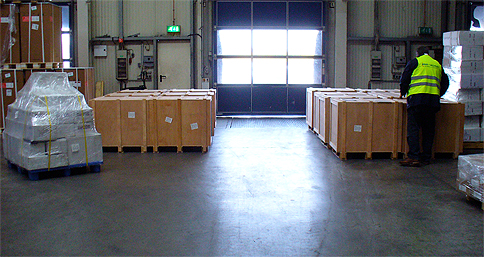 |
The shipping boxes are being provided with the addresses
of the recipients
|